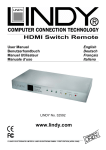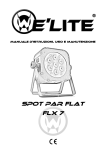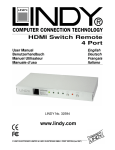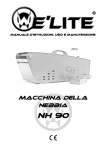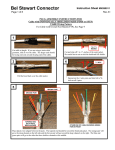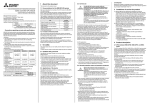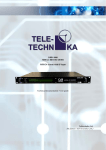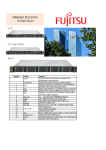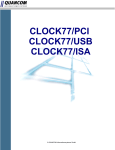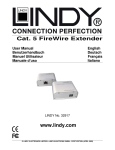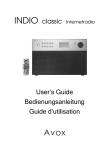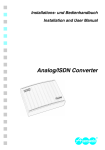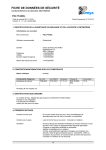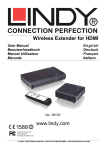Download HDMI 4K Extender Premium C6 100m User Manual English
Transcript
HDMI 4K Extender Premium C6 100m User Manual Benutzerhandbuch Manuel Utilisateur Manuale d’uso English Deutsch Français Italiano LINDY No. 38115 www.lindy.com © LINDY ELECTRONICS LIMITED & LINDY-ELEKTRONIK GMBH - FIRST EDITION (AUGUST 2013) User Manual English Introduction Thank you for purchasing the LINDY HDMI 4K Extender Premium C6 100m. It supports uncompressed Full HD 1080p and UHD 4K HDMI signal transmissions for high resolution computer graphics and fluent video transmission, at distances up to 100m using high quality Cat.6/Cat.7 RJ45 cable using HDBaseT technology. In addition to extending HDMI signals the extender also supports the extension of RS232 and Infrared signals and also operates as a 3 port 10/100 Ethernet Switch. For added convenience and flexibility the Receiver unit is powered from the Transmitter over the Cat.6/7 cable using the HDBaseT PoE feature. Package Contents 1 x Transmitter, 1 x Receiver Multi-Country Power Adapter (100 - 240VAC / 24V DC/1.25A) IR Transmitter/Emitter – 1.4m Cable IR Receiver – 1.4m Cable This User Manual Features Extends uncompressed HDMI or DVI-D signals up to 100m via its HDBaseT connection HDMI FullHD 1080p including Deep Color and 3D and UHD 4K or DVI-D up to 1920 x 1200 Supports 10/100 Base-T Ethernet via the HDBaseT connection (2 x 3 Port 10/100 Ethernet) Supports hardware RS232 link function and Infrared remote signal transmission Supports a local HDMI monitor connected to the Transmitter * Suitable for use with 3D/HDTV Home Theater, professional HDTV installations, Computer Systems, Multimedia and Control Center system installations. * Please Note: The local HDMI output of the Transmitter may not be used at the same time as the HDBaseT connection Specification HDBaseT connection uses RJ45 cable. The HDBaseT connection is a dedicated cable connection, it is not a Gigabit Ethernet connection! Maximum cable length 100m Compatible with HDMI up to 1.4 and DVI 1.0, with HDCP, up to 10.2 Gbps / 340MHz per link FullHD 1080p with up to 36/12 bit colour depth with 3D support and 4k and HDMI CEC support. Supported resolutions: 640x480i, 720x480i/p, 720x576i/p, 1024x768, 1280x720i/p, 1280x960, 1280x1024, 1600x1200, 1920x1080i/p, 1920x1200 & 4K Supported audio: multi-channel including all HDMI supported protocols, DTS-HD Master Audio, Dolby Digital Plus, Dolby TrueHD IR sensor and IR Transmitter connections on the units support IR frequencies 30-50kHz. RS232 DB-9 Connector on the Transmitter and Receiver with Bi-directional transfer up to 192Kbps Transmitter and Receiver each have a 3 RJ45 ports switch for 10/100 Ethernet support. The 10/100 switches are connected via the HDBaseT connection The Receiver is powered via the HDBaseT connection from the Transmitter 3 User Manual English Installation Important! Before starting the installation, please ensure that all devices are powered off. VERY IMPORTANT: never use a network connection with any active LAN components for the HDBaseT link – this may destroy the Extender !!! The following steps are for an installation using HDMI equipment, if you are using DVI equipment, please substitute the HDMI cables for DVI to HDMI cables where required. 1. Connect your HDMI source to the HDMI Extender Transmitter unit using a HDMI cable (maximum length 10m). If required you may connect a local HDMI monitor during installation – this monitor must be disconnected when the HDBaseT connection is being used. 2. Connect one end of the Cat.6/7 cable (max. length 100m) to the HDBaseT link port on the Transmitter and the other end to the Receiver. Use solid core installation cable of at least Cat.6 UTP. 3. Use another HDMI cable (maximum length 10m) to connect your HDMI display device to the HDMI output port on the Receiver unit. 4. For RS232 Extender functionality, connect a DB-9 cable on the Transmitter and on the Receiver. 5. For additional Infrared remote signal functionality, connect the included IR cables to the units and place the transmitter in front of the HDMI device’s IR receiver. 6. For Ethernet functionality, connect your devices to the 10/100Base-T ports. 7. Plug the DC power supply into the HDMI transmitter unit and switch on. 8. Power on your HDMI Source and Display to complete the installation. 9. The LINK Led on the Transmitter and Receiver will illuminate when the HDBaseT Link between the Transmitter and Receiver is established. Troubleshooting There is no display on the screen. Check that the DC plug and jack used by external power supply are firmly connected. The Power LED must be lit. If the LED is not lit on Transmitter please check/replace the power supply. If the LED is not lit on Receiver but is lit on the Transmitter please re-check both units by connecting them with a short (~2m) patch cable. If the situation remains please contact LINDY Tech Support. Check that the Cat.6/7 cable is plugged in correctly and that both Link Status LED are lit. Check that the HDMI source and display are both powered on and active. When using the HDBaseT link the local monitor on Transmitter HDMI Bypass port MUST be disconnected! Power off all the devices, then power on in this order: first, the Transmitter unit, then the display and finally the HDMI source. For several HDMI devices it may be helpful to unplug and replug their HDMI connection to re-initiate the HDMI handshake and recognition. Reduce the length of Cat.6/7 or HDMI cable used, or use a higher quality cable. 4 Handbuch Deutsch Einführung Mit dem LINDY HDMI 4K Digital Signage Extender Premium C6 100m haben Sie ein erstklassiges Produkt erworben. Es unterstützt die Übertragung von unkomprimierten FullHD 1080p und auch 4K Signalen mit hoher Auflösung für Grafikausgabe als auch mit flüssiger Videowiedergabe über HDBaseT Technologie! Signale können bis zu 100m bei Verwendung hochwertiger Cat.6/7 RJ45 Kabel übertragen werden. Für beste Resultate besonders bei großen Distanzen empfehlen wir als Verbindungskabel das LINDY Cat.7 S/FTP PiMF Kabel Nr.12047. Der Extender arbeitet sowohl als HDMI wie auch als RS232, Infrarot IR-Fernbedienungs-, und 10/100 Ethernet Extender. Er unterstützt das PoE Feature, der Receiver wird vom Netzteil des Transmitters aus mit Strom versorgt. Lieferumfang 1x Transmitter, 1x Receiver Multi-Country Netzteil (100…240VAC / 24V DC/~1,25A) IR-Transmitter (Sender, klein) und IR-Receiver (Empfänger, groß), je mit ca.1,4m Kabel Dieses Handbuch Eigenschaften Sendet unkomprimierte HDMI oder DVI-D Signale über seine HDBaseT Verbindung HDMI FullHD 1080p einschließlich Deep Colour und 3D sowie 4K oder DVI-D bis 1920x1200 Unterstützt 10/100 Base-T Ethernet über die HDBaseT Verbindung (2x 3 Port 10/100) Unterstützt Hardware RS232 Verbindung und Übertragung der IR-Fernbedienungssignale Unterstützt einen lokalen HDMI Monitor am Transmitter alternativ zur HDBaseT Verbindung Ideal geeignet zum Einsatz im Bereich 3D/HDTV Home Theater, bei professionellen HDTV Installationen, Computersystemen, Multimedia und Control Center Installationen. Spezifikationen HDBaseT Verbindung via RJ45 Kabel. HDBaseT ist eine dedizierte Verbindung und nicht eine Gigabit Ethernet Verbindung! Maximale Kabellänge ca. 100m. Kompatibel mit HDMI bis 1.4 und DVI 1.0 mit HDCP, bis 10.2Gbps / 340MHz Link FullHD 1080p bis 36/12 Bit Farbtiefe mit 3D sowie 4K und HDMI CEC Unterstützung Unterstützte Auflösungen: 640x480i, 720x480i/p, 720x576i/p, 1024x768, 1280x720i/p, 1280x960, 1280x1024, 1600x1200, 1920x1080i/p, 1920x1200, 4K Unterstützte Audioformate: Multi-Channel inkl. aller HDMI unterstützten Protokolle, DTSHD Master Audio, Dolby Digital Plus, Dolby TrueHD IR-Sensor am Transmitter und IR-Sender am Receiver, transparent ohne Protokollbindung ~30…50kHz, Reichweite bis15m (20kHz IR nicht unterstützt – z.B. verschiedene Sky Boxen) RS232 DB-9 Anschlüsse mit Unterstützung für bidirektionalen Datentransfer bis 192000Bit/s Transmitter und Receiver mit RJ45 3 Port 10/100 Ethernet Switch. Der Receiver wird über die HDBaseT Verbindung vom Transmitter mit Strom versorgt 5 Handbuch Deutsch Installation und Inbetriebnahme Bitte schalten Sie vor Beginn der Installation alle Geräte aus. SEHR WICHTIG: Verwenden Sie niemals eine Netzwerkverbindung mit aktiven LAN Komponenten – dies kann zur Zerstörung des Extenders führen !!! Die folgenden Schritte beschreiben die Installation mit HDMI Geräten. Bei Verwendung von DVI Geräten ersetzen Sie bitte die HDMI-Kabel durch HDMI-DVI-Kabel. 1. Verbinden Sie Ihre HDMI Signalquelle mit dem HDMI Extender Transmitter mit einem HDMI Kabel (max. Länge 10m). Falls benötigt schließen Sie auch einen HDMI Monitor an 2. Schließen Sie das eine Ende des Cat.6/7 Kabels (max. Länge 100m) am HDBaseT Port am Transmitter und das andere Ende am HDBaseT Port am Receiver an. Verwenden Sie Installationskabel mit starren Adern (solid core) mindestens der Qualität 22/24AWG Cat.6 UTP. RJ45-Belegung analog zu 568-B. Besonders bei großen Distanzen empfehlen wir als Verbindungskabel unbedingt das LINDY Cat.7 S/FTP PiMF Kabel Art.-Nr.12047 3. Schließen Sie mit einem HDMI Kabel (max. 10m) Ihr HDMI Display am Receiver an 4. Zur Nutzung der RS232 Funktion schließen Sie bitte ihre Geräte mit DB-9 Anschlusskabeln (1:1 Verbindung) an. 5. Zur Übertragung von IR-Fernbedieungssignalen schließen Sie die beiliegenden IR Kabel an und platzieren Sie sie entsprechend 6. Zur Nutzung der Ethernetfunktion müssen Sie lediglich ihre Geräte anschließen 7. Schließen Sie das Netzteil am Transmitter an und schalten Sie ein 8. Schalten Sie anschließend Ihren HDMI Monitor und die Signalquelle ein • Die LINK LEDs an TX und RX müssen aufleuchten sobald der HDBaseT Link erfolgreich etabliert wurde Fehlersuche und -behebung Der Monitor zeigt kein Bild Prüfen Sie ob das Netzteil korrekt angeschlossen ist. Wenn die Power LED am TX nicht leuchtet überprüfen Sie bitte das Netzteil und tauschen Sie es ggf. aus. Wenn die LED am TX leuchtet aber nicht am RX, überprüfen Sie die Verbindung von TX und RX ggf. mit einem kurzen (~2m) abgeschirmten Patchkabel. Falls der Fehler bestehen bleibt kontaktieren Sie bitte den LINDY Techniksupport. Prüfen Sie dass das Cat.6/7 Kabel korrekt angeschlossen ist und dass die Link Status LEDs leuchten. Es MUSS eine direkte Kabelverbindung sein, eine Netzwerkverbindung mit aktiven Komponenten kann NICHT verwendet werden! Schalten Sie alle Geräte aus und in der folgenden Reihenfolge wieder ein: zuerst den Transmitter (der Receiver wird dann auch sofort über die HDBaseT Verbindung mit Strom versorgt), dann den HDMI Monitor und dann die HDMI Quelle. Bei verschiedenen HDMI Geräten kann es erforderlich sein nochmals das HDMI Kabel abzuziehen um den HDMI Handshake Link erneut zu initialisieren. Verringern Sie die Kabellänge des Cat.6/7 und HDMI Kabels oder verwenden Sie ein höherwertiges Verbindungskabel wenn die Link LEDs nicht leuchten. Kontrollieren Sie ob die RJ45 Stecker korrekten Kontakt und die richtige Pinbelegung 568-B verwenden. 6 User Manual Français Introduction Merci d’avoir choisi l’extender LINDY HDMI 4K Digital Signage Premium C6 100m! Il supporte la transmission de signaux HDMI non compressés en FullHD 1080p et le 4K ! Cet extender vous permet d’étendre des signaux jusqu’à 100m en utilisant des câbles réseau cat.6/Cat.7 RJ45. Pour de meilleurs résultats et surtout de longues distances, nous recommandons d’utiliser notre câble cat.7 S/FTP PiMF (N° Art. 12047). Cet extender fonctionne comme un extender HDMI cat.6, extender RS232, extender infrarouge cat.6 et comme extender Ethernet avec switch 3 ports. Le récepteur est alimenté via le câble de connexion venant de l’émetteur (fonction HDBaseT PoE). Contenu 1x émetteur, 1x récepteur Alimentation multi pays (100…240VAC / 24V DC/1,25A) Emetteur IR (compact), et récepteur IR (large) avec câble de 1,4m Emetteur IR avec 1.5m de câble Ce manuel Caractéristiques Etend des signaux HDMI ou DVI-D non compressés jusqu’à 100m via sa connexion HDBaseT HDMI FullHD 1080p, y compris Deep Color, 3D et 4K, ou DVI-D jusqu’à 1920 x 1200 Supporte Ethernet 10/100 Base-T via la connexion HDBaseT (2x 3 ports 10/100 Ethernet) Supporte la transmission de signaux RS232 et infrarouge Supporte un écran local HDMI pour le boîtier récepteur Convient pour les installations Home Cinéma 3D/HDTV, ordinateurs. Spécifications La connexion HDBaseT est dédiée avec un câble RJ45, ce n’est pas une connexion Ethernet! Longueur maximale du câble pour la connexion HDBaseT: 100m (environ) Compatible HDMI jusqu’à 1.4 et DVI 1.0, HDCP, jusqu’à 10.2Gbps / 340MHz FullHD 1080p avec jusqu’à 36/12 bits en profondeur de couleur, avec support 3D, 4K et HDMI CEC Résolutions supportées: 640x480i, 720x480i/p, 720x576i/p, 1024x768, 1280x720i/p, 1280x960, 1280x1024, 1600x1200, 1920x1080i/p, 1920x1200, 4K Formats audio supportés: multi canal incluant tous les protocoles HDMI, DTS-HD Master Audio, Dolby Digital Plus, Dolby TrueHD Capteur infrarouge sur l’unité émettrice et émetteur infrarouge sur l’unité réceptrice, supportent les fréquences IR 30-50kHz, ils ne supportent pas les IR 20kHz de certaines box Prise RS232 DB-9 sur les deux unités avec transfert bidirectionnel, jusqu’à 192000 Bit/s Les deux unités ont chacune un switch 3 ports RJ45 10/100. Ces deux switchs 10/100 sont donc connectés via la liaison HDBaseT Le récepteur est alimenté par la connexion HDBaseT de l’émetteur Dimensions: 15 x 7 x 5cm (P x L x H) ; poids: 0.46kg (chaque unité) Température d’utilisation: 0-70°C. A utiliser à l’intérieur uniquement 7 User Manual Installation Français Important! Avant de démarrer l’installation, merci de vérifier que tous les appareils sont éteints. TRES IMPORTANT: ne jemais utiliser une connexion réseau avec des équipements réseau actifs – cela endommagerait l’extender !!! Les étapes suivantes sont pour l’installation d’un équipement HDMI, si vous êtes en DVI, merci de remplacer vos câbles HDMI par des câbles DVI vers HDMI. 1. Connectez votre source HDMI à l’extender HDMI Emetteur en utilisant un câble HDMI (longueur maximale : 10m). Si nécessaire, vous pouvez connecter un écran local HDMI. 2. Connectez une extrémité du câble cat.6/7 (longueur maximale: 100m) sur le port the HDBaseT link du Récepteur et l’autre sur port Gigalink du Récepteur. Utilisez des câbles réseau monobrin, au mieux 22/24AWG cat.6 UTP; en respectant la connectique RJ45 568-B. Pour de meilleurs résultats sue de longues distances, nous recommandons d’utiliser des câbles cat.7 S/FTP PiMF (N° Art. 12047). 3. Utilisez un autre câble HDMI (longueur maximale: 10m) pour connecter votre écran HDMI vers le port de sortie de l’unité réceptrice. 4. Pour la fonction extender RS232, connectez un câble DB-9 (droit 1:1) sur l’Emetteur et sur le Récepteur. Le périphérique RS232 connecté au Récepteur sera le périphérique distant. 5. Pour le support infrarouge, connectez les câbles IR fournis aux 2 unités, puis placez la télécommande IR en face du récepteur IR 6. Pour le support Ethernet, connectez vos appareils réseau aux ports 10/100Base-T. 7. Connectez l’alimentation DC dans l’émetteur HDMI et allumez-le. 8. Allumez la source HDMI et l’écran pour terminer l’installation. La LED “LINK” de l’émetteur et du récepteur doit s’allumer quand le lien HDBaseT Link est établi Dépannage Il n’y a pas d’affichage sur l’écran. Vérifiez que la prise DC de l’alimentation est correctement connectée. La LED “Power doit être allumée. Si la LED n’est pas allumée sur TX, merci de vérifier ou remplacer l’alimentation. Si la LED n’est pas allumée sur RX mais que sur TX, merci vérifier les unités en ne connectant qu’un câble court (2m) et blindé. Si la situtation reste la même, merci de contacte le support technique LINDY. Vérifiez que le câble cat.6/7 est bien connecté et que les LED « Link Status » soient allumées. Vérifiez que la source HDMI et l’écran soient allumés et actifs. Le moniteur local connecté en TX HDMI Bypass DOIT être déconnecté ! Eteignez tous les appareils, puis allumez-les dans cet ordre: d’abord l’émetteur, le récepteur (le récepteur est immédiatement alimenté par le lien Gigalink venant de l’émetteur), puis l’écran et finalement la source. Pour plusieurs appareils HDMI, il peut être utile de déconnecter/connecter leur connexion HDMI pour réinitialiser la synchro HDMI. Réduisez la longueur de câbles cat.6/7 utilisés, ou utilisez-en de meilleure qualité. Vérifiez si les connecteurs RJ45 soient bien maintenus par le câble et qu’ils utilisent un câblage 568-B. Utilisez des câbles HDMI plus courts pour des problèmes avec les appareils HDMI. 8 Manuale Italiano Introduzione Grazie per aver scelto il LINDY HDMI 4K Digital Signage Extender Premium C6 100m! Supporta segnali FullHD 1080p HDMI non compressi ad alta risoluzione per trasmissioni di alta qualità, anche 4K. Questo Extender consente di inviare segnali a 100m con cavi RJ45 Cat.6/Cat.7 di alta qualità. Per ottenere le migliori performance specialmente su lunghe distanze consigliamo l’utilizzo del nostro cavo Cat.7 S/FTP PiMF (Art.12047). Questo prodotto funziona come extender HDMI, extender RS232, extender infrarossi e come Ethernet Switch extender 3 porte. Il ricevitore viene alimentato dal trasmettitore tramite il cavo di rete (funzione HDBaseT PoE). Contenuto della confezione 1 trasmettitore, 1 ricevitore Alimentatore Multi-Country (100…240VAC / 24V DC/~1,25A) Trasmettitore IR (emettitore piccolo) e ricevitore IR (più grosso) con cavo da ~1.4m Questo manuale Caratteristiche Estende segnali HDMI o DVI-D non compressi fino a 100m tramite cavo di rete HDMI FullHD 1080p incluso Deep Color, 3D e 4K o DVI-D fino a 1920 x 1200 Supporto Ethernet 10/100 Base-T via connessione HDBaseT (2x 3 porte 10/100 Ethernet) Supporta la trasmissione si segnali RS232 ed a infrarossi Supporta la connessione di un monitor HDMI locale sul trasmettitore Ideale per Home Theater 3D/HDTV, installazioni HDTV professionali, Computer, applicazioni multimediali e sistemi di controllo centralizzato. Specifiche La connessione HDBaseT lavora su cavo di rete RJ45. HDBaseT è una connessione via cavo dedicata, non è una connessione Gigabit Ethernet! La distanza massima supportata è di 100m ca. Compatibile con gli standard HDMI fino a 1.4 e DVI 1.0, HDCP, 10.2Gbps / 340MHz FullHD 1080p profondità colori 36/12 bit con supporto 3D e HDMI CEC Risoluzioni supportate: 640x480i, 720x480i/p, 720x576i/p, 1024x768, 1280x720i/p, 1280x960, 1280x1024, 1600x1200, 1920x1080i/p, 1920x1200, 4K Supporto audio: multi-channel compreso i protocolli HDMI, DTS-HD Master Audio, Dolby Digital Plus, Dolby TrueHD I sensori IR su trasmettitore e ricevitore supportano frequenze IR 30-50kHz – Non supportano frequenze di 20kHz come in alcuni Sky box Connettore RS232 DB-9 su entrambe le unità, trasferimento dati bi-direzionale fino a 192000 Bit/s Trasmettitore e ricevitore con 3 porte RJ45 ciascuno, switch con supporto Ethernet 10/100. Gli switch 10/100 possono essere collegati anche tramite connessione HDBaseT Il ricevitore è alimentato tramite la connessione HDBaseT dal trasmettitore 9 Manuale Italiano Installazione Importante! Prima di iniziare l’installazione assicuratevi che tutti i dispositivi siano spenti. Non usare MAI una connessione LAN con componenti attivi per la connessione HDBaseT, potrebbe danneggiare l’Extender!!! I passaggi seguenti sono riferiti ad un’installazione tipo con dispositivi HDMI, se utilizzate apparecchiature DVI considerate cavi DVI / HDMI al posto di cavi HDMI dove indicato. 1. Collegate la vostra sorgente HDMI al Trasmettitore con un cavo HDMI (lunghezza massima 10m). Potete anche collegare un monitor HDMI locale in aggiunta. 2. Collegate un capo del cavo Cat.6/7 (lungo fino a 100m) alla porta HDBaseT sul Trasmettitore e l’altro capo alla porta Gigalink del Ricevitore. Utilizzate un cavo 22/24AWG Cat.6 UTP; RJ45 conforme alla codifica 568-B. Per le migliori performance specialmente su lunghe distanze consigliamo l’utilizzo del nostro cavo Cat.7 S/FTP PiMF (Art.12047). 3. Utilizzate un altro cavo HDMI (lungo non più di 10m) per collegare il monitor HDMI all’uscita HDMI sul Ricevitore. 4. Per utilizzarlo come extender RS232 collegate un cavo DB-9 (1:1) sul Trasmettitore e sul Ricevitore. Il dispositivo RS232 collegato al Ricevitore è da considerarsi periferica remota. 5. Per inviare segnali a infrarossi collegate i cavi IR alle unità e posizionate il trasmettitore di fronte al dispositivo HDMI con il ricevitore IR 6. Per la funzione Ethernet, collegate i vostri dispositivi alle porte 10/100Base-T 7. Collegate l’alimentazione al trasmettitore HDMI ed accendetelo 10. Accendete anche la sorgente HDMI e il monitor per completare l’installazione • LINK Led su trasmettitore e ricevitore: questi LED si accendono una volta stabilita la connessione HDBaseT tra TX e RX Soluzione Problemi Non compare nessun segnale video. Controllate che il connettore dell’alimentatore sia inserito correttamente. Il LED power deve accendersi, se ciò non avviene controllate o sostituite l’alimentatore. Se il LED non si accende solo sul ricevitore provate a sostituire il cavo di rete utilizzato con uno schermato e corto (~2m) Controllate che il cavo Cat.6/7 sia inserito correttamente e che i LED siano accessi. Controllate che la sorgente HDMI e il monitor siano entrambi accesi ed attivi. Quando utilizzate la connessione HDBaseT non collegare un monitor locale sulla porta bypass del trasmettitore! Spegnete tutti i dispositivi e riaccendeteli nel seguente ordine: prima il trasmettitore (il ricevitore si accende automaticamente tramite il collegamento Gigalink), quindi il monitor e in fine la sorgente. Per molti dispositivi HDMI può essere necessario scollegare e ricollegare i cavi HDMI per riavviare il riconoscimento HDMI. Ridurre la lunghezza del cavo Cat.6/7 oppure utilizzarne uno di qualità superiore. Controllate che i connettori RJ45 siano installati correttamente al cavo secondo la codifica 568-B. Utilizzate cavi HDMI più corti. 10 Technical Specifications Max. 12Gbit/s. total bandwidth over HDBaseT connection using RJ45 cable. The HDBaseT connection is a dedicated cable connection, it is not a Gigabit Ethernet connection! Solid core installation cable must be used to reach large distances. Maximum cable length for the HDBaseT connection: 100m (approx.) Compatible with HDMI 1.2, 1.3a/b/c, 1.4 and DVI 1.0 with HDCP, up to 10.2 Gbps / 340MHz per link FullHD 1080p with up to 36/12 bit colour depth with 3D support and HDMI CEC support Supported resolutions: 640x480i, 720x480i/p, 720x576i/p, 1024x768, 1280x720i/p, 1280x960, 1280x1024, 1600x1200, 1920x1080i/p, 1920x1200, 4K Supported audio: multi-channel including all HDMI supported protocols, DTS-HD Master Audio, Dolby Digital Plus, Dolby TrueHD IR sensor and IR transmiter supported on both units with up to 15m signal distance IR frequencies 30 – 50kHz supported – 20kHz not supported (i.e. some Sky boxes) RS232 DB-9 Connector on TX and RX with Bi-directional transfer up to 192000 Bit/s Transmitter and Receiver each have a 3 RJ45 ports switch for 10/100 Ethernet support. The 10/100 switches are also connected via the HDBaseT connection Receiver is powered via the HDBaseT connection from transmitter Operating Temperature ~0 – 40 °C / ~32 – 104°F Storage Temperature ~-20 – 60°C / -4 – 140 °F Relative Humidity ~20 – 90 % RH (non condensing) – For Indoor Use Only Dimensions: approx. 13 x 13 x 3cm (L x W x H) ; Weight: ~0.4kg (each unit) Multi-Country wall mount power supply (100…240VAC / 24V DC/~1.25A) Power Consumption typical 6W (TX) and 8W (RX) Pin Assignment of RJ45 connector acording to 568-B Pin Assignment of IR TX and RX IR Transmitter Power 5V IR transmitter signal NC IR receiver signal Power 5V Ground 11 Radio Frequency Energy, Certifications, Recycling Information FCC Warning This equipment has been tested and found to comply with the limits for a Class B digital device, pursuant to part 15 of the FCC Rules. These limits are designed to provide reasonable protection against harmful interference in a residential installation. This device complies with part 15 of the FCC Rules. Operation is subject to the following two conditions: 1. This device may not cause harmful interference, and 2. This device must accept any interference received, including interference that may cause undesired operation. CE Certification This equipment complies with the requirements relating to electromagnetic compatibility, EN 55024 and EN55022 ITE. This equipment has been manufactured under the scope of RoHS compliance. WEEE (Waste of Electrical and Electronic Equipment), Recycling of Electronic Products In 2006 the European Union introduced regulations (WEEE) for the collection and recycling of all waste electrical and electronic equipment. It is no longer allowable to simply throw away electrical and electronic equipment. Instead, these products must enter the recycling process. Each individual EU member state has implemented the WEEE regulations into national law in slightly different ways. Please follow your national law when you want to dispose of any electrical or electronic products. More details can be obtained from your national WEEE recycling agency. Germany / Deutschland Die Europäische Union hat mit der WEEE Direktive umfassende Regelungen für die Verschrottung und das Recycling von Elektro- und Elektronikprodukten geschaffen. Diese wurden in Deutschland im Elektro- und Elektronikgerätegesetz – ElektroG in deutsches Recht umgesetzt. Dieses Gesetz verbietet das Entsorgen von entsprechenden, auch alten, Elektro- und Elektronikgeräten über die Hausmülltonne! Diese Geräte müssen den lokalen Sammelsystemen bzw. örtlichen Sammelstellen zugeführt werden! Dort werden sie kostenlos entgegen genommen. Die Kosten für den weiteren Recyclingprozess übernimmt die Gesamtheit der Gerätehersteller. France En 2006, l'union Européenne a introduit la nouvelle réglementation (DEEE) pour le recyclage de tout équipement électrique et électronique. Chaque Etat membre de l’ Union Européenne a mis en application la nouvelle réglementation DEEE de manières légèrement différentes. Veuillez suivre le décret d’application correspondant à l’élimination des déchets électriques ou électroniques de votre pays. Italy Nel 2006 l’unione europea ha introdotto regolamentazioni (WEEE) per la raccolta e il riciclo di apparecchi elettrici ed elettronici. Non è più consentito semplicemente gettare queste apparecchiature, devono essere riciclate. Ogni stato membro dell’ EU ha tramutato le direttive WEEE in leggi statali in varie misure. Fare riferimento alle leggi del proprio Stato quando si dispone di un apparecchio elettrico o elettronico. Per ulteriori dettagli fare riferimento alla direttiva WEEE sul riciclaggio del proprio Stato. LINDY Herstellergarantie – Hinweis für Kunden in Deutschland LINDY gewährt für dieses Produkt über die gesetzliche Regelung in Deutschland hinaus eine zweijährige Herstellergarantie ab Kaufdatum. Die detaillierten Bedingungen dieser Garantie finden Sie auf der LINDY Website aufgelistet bei den AGBs LINDY No 38115 1st Edition, August 2013 www.lindy.com












